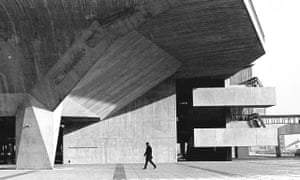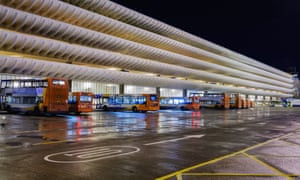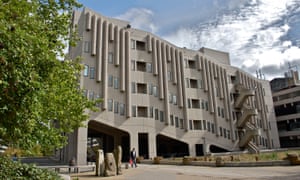For me the most exciting building in any town is always the brutalist one. It is architecture on heat: it struts, invites you to rub its porridgey skin and goggle at its projections. There is a reason that music videos are shot in them, rather than in drab supermarkets.
Over the past couple of years I have been writing a book about brutalism, Concrete Concept, and I have noticed that change is afoot. The style has been re-appraised for some time now, and not just among the aficionados. In an era of wavering faith in capitalism, brutalism’s robust statements are finding a fresh audience. Buildings such as Erno Goldfinger’s Trellick Tower in west London, or Leeds University, once the butt of endless jokes, are now some of the country’s hippest structures. They serve as squat grey ripostes to the 10-a-penny oligarch vanity projects that seem to arrive daily on the skyline.
The brutalist style harks back to an idealistic postwar world where even Conservative governments built council houses; an epoch when carving out a collective future, rather than endlessly showing off on Facebook, was the esprit du temps. Brutalist buildings might look like they want to slap you in the face, but they’re solid and dependable – the opposite of so many of today’s splutters on the skyline, which look like they’ll fall over if you mumble “Fee-fi-fo-fum” near to them.

From the start, brutalism was about going wild with concrete. The term slithered from many streams: nybrutalism in Sweden; British architects Alison and Peter Smithson’s designs; the French béton brut – raw concrete. During the 1960s it sprouted from the Côte d’Ivoire to Canada, and concrete salesmen grew rich on the proceeds.
These buildings tell stories: the Apollo Pavilion in Peterlee asserts the muscle and pride of the Durham colliers. Sampson House in London, with its lack of doors and windows, alludes to the tiny terrors of office life and of computers that might one day be running us.
Although the material is tough, this machine-age aesthetic could be quite feminine. The Southbank’s Hayward Gallery – currently being renovated – is beautiful yet complex. It lures you in, but you’ll never fully understand it.
When they were built, these were symbols of power: monuments to the “we know best” welfare state or corporations or God (Germany’s concrete churches, such as Gottfried Böhm’s at Neviges, are sublime). Nowadays, brutalism is championed by outsiders and knocked down by bureaucrats lacking taste. Portsmouth council destroyed Rodney Gordon’s Tricorn in 2004, and Birmingham has just started vandalising John Madin’s Central Library.

All is not lost, however. The number of brutalist maps, models, posters and cushions emerging suggests that brutalist buildings could have a future as tourist attractions. Word is spreading. The National Trust recently hosted brutalism tours. And punters cough up to live at Park Hill in Sheffield because it’s “cool”. As for the former council residents… well, that’s the free market for you, isn’t it?
These buildings yield so much. For all their ostensible oddness, brutalist buildings don’t have to be movie dystopias. In Rotterdam this month I watched a condemned brutalist block having its front peeled off – to reveal each flat’s walls painted or papered in different shades. Normal homes for normal people. These futuristic buildings, built to prepare us for a world of jetpacks and robots, were colonised by teenagers to skateboard in and chug cider. Brutalist buildings are everywhere, waiting for some attention. They deserve it.
[“source-theguardian”]



























